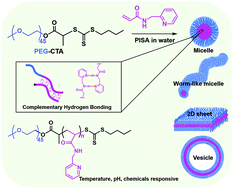Pyridine-containing block copolymeric nano-assemblies obtained through complementary hydrogen-bonding directed polymerization-induced self-assembly in water†
Abstract
Pyridine-containing block copolymers are a special type of macromolecule, and they can self-assemble into highly-ordered nano-objects for a wide range of applications due to their multiple properties including hydrogen bond acceptance, pH sensitivity, facile functionalization and metal ion coordination. However, it still remains a critical challenge to design and fabricate pyridine-containing block polymeric nano-assemblies in a large scale in aqueous media. In this contribution, we reported a new type of pyridine-containing block-copolymer of polyethylene glycol-block-poly(N-(2-methylpyridine)-acrylamide) (PEG-PMPA), which can self-organize into nano-assemblies through reversible addition–fragmentation chain transfer (RAFT) polymerization-induced self-assembly (PISA) in water. Differing from the traditional hydrophobicity for driving the self-assembly of block-copolymers during polymerization, we here utilized the complementary hydrogen bonding interaction between the pyridine and the amide group to direct the organization of the block-copolymers with PMPA chain extension in polymerization. This facile strategy provides a new avenue to the scale-up preparation of smart and diversiform pyridine-containing polymer nanomaterials with potential applications in biomedicine.



 Please wait while we load your content...
Please wait while we load your content...